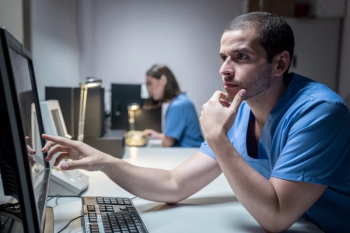A multimodal model that combines insights from multiparametric magnetic resonance imaging (mpMRI) radiomics, clinical characteristics, pathomics and deep learning may provide enhanced accuracy in forecasting long-term outcomes for women who receive neoadjuvant chemotherapy (NAC) for breast cancer.
For the retrospective study, recently published in Academic Radiology, researchers compared the aforementioned multimodal model (Deep feature-based patho-radiomic model or DFPM) to an MRI alone model, a pathomic model and a deep learning pathomic model for predicting five-year and seven-year overall survival (OS) outcomes after receiving NAC for breast cancer. The cohort for the multicenter study was comprised of 216 patients with breast cancer who completed NAC, according to the study.
In internal validation testing, the study authors found that that the multimodal DFPM model offered an 82 percent AUC for five-year OS in contrast to 66 percent for the MRI-only model and 69 percent for the pathomic model. While a deep learning pathomic model offered an 86 percent AUC at five and seven years for OS, the researchers noted the DFPM model had an 87 percent AUC for seven-year OS, which was 14 percent higher than the pathomic model (73 percent) and 9 percent higher than the MRI-only model (78 percent).
The study authors maintained that the combination of imaging, pathology and clinical data significantly bolsters the accuracy of long-term survival prediction for those treated with NAC for breast cancer.
“This represents a meaningful advancement over existing models that rely on single-modality data or focus on short-term outcomes,” wrote lead study author Quan Yuan, M.D., who is affiliated with the Department of Breast Surgery at Harbin Medical University Cancer Hospital in Heilongjiang, China, and colleagues.
Three Key Takeaways
• Multimodal modeling significantly enhances long-term survival prediction. The DFPM model, which integrates mpMRI radiomics, pathomics, clinical features, and deep learning, showed substantially higher AUCs for five- and seven-year OS than MRI-only and pathomic models.
• DFPM provides a more comprehensive long-term assessment than pCR. By capturing macroscopic heterogeneity, microscopic morphology, and deep learning–derived latent features, the model offers richer prognostic insight into residual disease biology than the binary pCR metric.
• Deep learning inputs may be essential drivers of performance gains for long-term survival prediction. The deep learning pathomic model achieved an 86 percent AUC for five- and seven-year OS. The combination of deep learning with radiomics and clinical data in DFPM yielded the highest seven-year OS accuracy (87 percent) of the reviewed models, demonstrating the potential additive value of multimodal integration.
While acknowledging the widespread utility of pathologic complete response (pCR) for assessing NAC treatment outcomes and multiple meta-analysis findings that demonstrate a correlation between pCR and higher survival rates, the study authors maintained that the DFPM model offers better long-term prediction of OS.
“This superiority arises because DFPM captures multidimensional tumor traits — macroscopic spatial heterogeneity via MRI radiomics, microscopic morphological patterns via pathomics, and latent features via deep learning — that pCR, a binary endpoint, cannot fully reflect. … Together, these features provide a more nuanced assessment of residual disease aggressiveness than pCR alone,” noted Yuan and colleagues.
(Editor’s note: For related content, see “Posr-NAC Breast MRI Without Calcifications Associated with 65 Percent Higher Likelihood of Pathologic Complete Response,” “Assessing Post-Treatment MRI for Predicting Neoadjuvant Chemoimmunotherapy Response for Triple-Negative Breast Cancer” and “Can Mid-Treatment MRI Help Predict Neoadjuvant Chemotherapy Response for Patients with Breast Cancer?”)
In regard to study limitations, the authors acknowledged the retrospective nature of the research, the lack of automated region of interest (ROI) segmentation for tumors and lack of external validation.





























